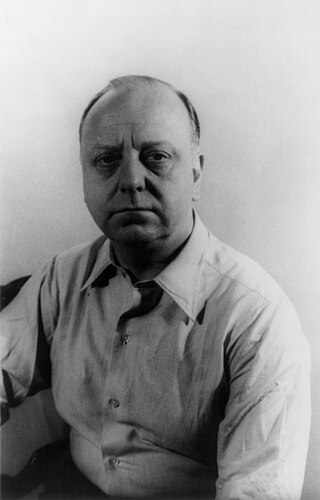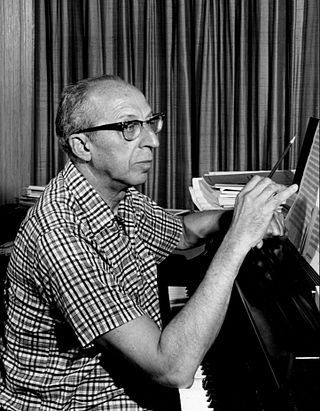Related Research Articles

Virgil Thomson was an American composer and critic. He was instrumental in the development of the "American Sound" in classical music. He has been described as a modernist, a neoromantic, a neoclassicist, and a composer of "an Olympian blend of humanity and detachment" whose "expressive voice was always carefully muted" until his late opera Lord Byron which, in contrast to all his previous work, exhibited an emotional content that rises to "moments of real passion".
Symphony No. 3 was Aaron Copland's final symphony. It was written between 1944 and 1946, and its first performance took place on October 18, 1946 with the Boston Symphony Orchestra performing under Serge Koussevitzky. If the early Dance Symphony is included in the count, it is actually Copland's fourth symphony.

Prelude, Fugue and Riffs is a "written-out" jazz-in-concert-hall composition composed by Leonard Bernstein for a jazz ensemble featuring solo clarinet.
English Folk Song Suite is one of English composer Ralph Vaughan Williams' most famous works. It was first published for the military band as Folk Song Suite and its premiere was given at Kneller Hall on 4 July 1923, conducted by Lt Hector Adkins. The piece was then arranged for full orchestra in 1924 by Vaughan Williams' student Gordon Jacob and published as English Folk Song Suite. The piece was later arranged for British-style brass band in 1956 by Frank Wright and published as English Folk Songs Suite. All three versions were published by Boosey & Hawkes; note the use of three different titles for the three different versions. The suite uses the melodies of nine English folk songs, six of which were drawn from the collection made by Vaughan Williams' friend and colleague Cecil Sharp.

Barbara Kolb was an American composer and educator, the first woman to win the Rome Prize in musical composition. Her music features sound masses of colorful textures, impressionistic sounds and atonal vocabulary, with influences from literary and visual arts. She taught at the Third Street Music School Settlement, Rhode Island College and Eastman School of Music.
Sinfonia da Requiem, Op. 20, for orchestra is a sinfonia written by Benjamin Britten in 1940 at the age of 26. It was one of several works commissioned from different composers by the Japanese government to mark Emperor Jimmu's 2600th anniversary of the founding of the Japanese Empire. The Japanese government rejected the Sinfonia for its use of Latin titles from the Catholic Requiem for its three movements and for its somber overall character, but it was received positively at its world premiere in New York on 29 March 1941 under John Barbirolli. A performance in Boston under Serge Koussevitzky led to the commission of the opera Peter Grimes from the Koussevitzky Music Foundations.
Capricorn Concerto, Op. 21, is a composition for flute, oboe, trumpet, and strings by Samuel Barber, completed on September 8, 1944. A typical performance lasts approximately 14 minutes.

Donald Henry Kay AM is an Australian classical composer.
Clare (Ewing) Grundman was an American composer and arranger.
Aaron Copland wrote the Symphony for Organ and Orchestra in 1924. It represents a major work in the composer's oeuvre, as it was his first fully realized orchestral work, his first work for organ, and the first piece whose orchestration he heard. It was premiered on January 11, 1925, in New York. In 1928, Copland re-orchestrated the work without organ as his Symphony No. 1, rewriting the organ part in the brass and adding saxophone.
Color Music is a suite of five different compositions for orchestra by American composer Michael Torke. The suite is well known for its association with the composer's synesthesia.
Letter from Home is a 1944 orchestral composition by Aaron Copland. The piece was commissioned as a patriotic work by Paul Whiteman for his Radio Hall of Fame Orchestra, and suggests the emotions of a soldier reading a letter from home. The music has been described as Copland's "most sentimental" and reflects his own homesickness in Mexico.
Soundings is an orchestral composition by the American composer Elliott Carter. The work was commissioned by the Chicago Symphony Orchestra for their final season with the conductor Daniel Barenboim as music director. It was first performed on October 6, 2005 at the Symphony Center, Chicago, by Barenboim and the Chicago Symphony Orchestra.
The Symphonia: sum fluxae pretium spei is an orchestral triptych by the American composer Elliott Carter. Its three movements were composed between 1993 and 1995. The complete work was first performed on April 25, 1998 at Bridgewater Hall, Manchester by the BBC Symphony Orchestra under the conductor Oliver Knussen. The second movement "Adagio tenebroso" was a finalist for the 1996 Pulitzer Prize for Music. The third movement "Allegro scorrevole" won The Prince Pierre of Monaco Music Composition Prize in 1998.
The Symphony No. 3 is a composition for orchestra by the American composer Ned Rorem. The work was first performed by the New York Philharmonic under the direction of Leonard Bernstein at Carnegie Hall on April 16, 1959.
The Piano Concerto is a composition for piano and orchestra by the Austrian composer Heinz Karl Gruber. The work was commissioned for the pianist Emanuel Ax by the New York Philharmonic, the Royal Stockholm Philharmonic Orchestra, the Berlin Philharmonic, and the Tonhalle Orchester Zürich. It was composed from 2014 through 2016 and was given its world premiere by Emanuel Ax and the New York Philharmonic under the direction of Alan Gilbert at David Geffen Hall on January 5, 2017.

Danzón cubano is a composition for two pianos by American composer Aaron Copland. The piece, written in 1942, was inspired by the Cuban genre of the same name. It was first arranged for orchestra in 1946.
The Concerto for Piano and Orchestra is a musical composition by the American composer Aaron Copland. The work was commissioned by the conductor Serge Koussevitzky who was then music director of the Boston Symphony Orchestra. It was first performed on January 28, 1927, by the Boston Symphony Orchestra conducted by Koussevitzky with the composer himself as the soloist. The piece is dedicated to Copland's patron Alma Morgenthau Wertheim.
The Short Symphony, or Symphony No. 2, is a symphony written by the American composer Aaron Copland from 1931 to 1933. The name derives from the symphony's short length of only 15 minutes. The work is dedicated to Copland's friend, the Mexican composer and conductor Carlos Chávez. The symphony's first movement is in sonata-allegro form, and its slow second movement follows an adapted ternary form. The third movement resembles the sonata-allegro but has indications of cyclic form. The composition contains complex rhythms and polyharmonies, and it incorporates the composer's emerging interest in serialism as well as influences from Mexican music and German cinema. The symphony includes scoring for a heckelphone and a piano while omitting trombones and a percussion section. Copland later arranged the symphony as a sextet.
References
- ↑ Copland, Aaron. "Quiet City" (full score), Boosey & Hawkes, 1941.
- ↑ Mason, Eric. "Quiet City". ClassicalPlus Works. Archived from the original on November 7, 2017. Retrieved November 1, 2017.
- ↑ "Aaron Copland's Forgotten Score Re-Emerges". NPR Music . November 12, 2011.
- ↑ Concert Bulletin of the Boston Symphony Orchestra, Sixtieth Season 1940-41, 1017-18.
- ↑ Aaron Copland; Vivian Perlis (1984). Copland 1900 Through 1942. St. Martin's Press. p. 287. ISBN 9780312169626.